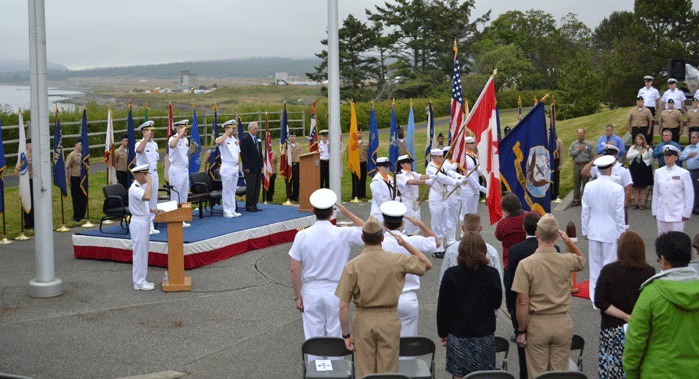A downpour by Mother Nature didn’t dampen spirits Friday at a 25th anniversary celebration for the Naval Ocean Processing Facility on board Naval Air Station Whidbey Island, but it did make for a slightly abbreviated ceremony.
Fifteen original plankowners were honored guests at the ceremony, which got underway with a VIP reception inside the classified building’s atrium. Retired Lt. Cmdr. Jack Moody and his wife, Patricia, who were also celebrating their 44th wedding anniversary, made the journey from their home north of Spokane to attend the celebration.
“I was the original maintenance officer,” Jack said, recalling the work required to build and transfer the facility from Pacific Beach.
“The first time I saw it, it was just a slab.”
It was the first time since Jack’s retirement 23 years ago that the couple had returned to Oak Harbor.
“The town has changed, but it looks good,” Jack said. “This place was a part of my life for three and a half years, so this is a good opportunity to come back and see it.”
“And it’s a great opportunity to reconnect with people,” added Patricia. “Plus, we were looking for something to do to celebrate our anniversary.”
The NOPF, one of just two such facilities in the country, is one of NAS Whidbey’s best-kept secrets. The best description of what goes on inside the high security facility is that it processes information it receives through a series of fixed and towed acoustic arrays throughout the Pacific Ocean. It is the duty of the nearly 400 personnel — including 40 from the Royal Canadian Navy — stationed there to monitor these listening posts 24 hours a day, seven days a week.
“The pace is a little slower than it is on a ship,” said Logistics Specialist 2nd Class (AW) Ryan Falconer, who has been at NOPF two years. “But it’s got to be — there’s not a lot of room for error.”
“My challenge is managing the personnel issues with the vast mission load of today’s Navy,” said Sonar Technician Submarine 2nd Class Christopher Adkins, Watch Supervisor. “I take pride however, in our ability to accomplish every mission.”
As the official ceremony got under way, thunder rumbled and the drizzle turned to steady rain. NOPF Commanding Officer, Cmdr. Jason Vogt, talked about the enduring mystique of the facility.
“What also endures is the camaraderie and teamwork,” he said, acknowledging the plankowners and encouraging young sailors to seek them out to share stories.
“We share a common bond of the IUSS (Integrated Undersea Surveillance System) mission,” Vogt said.
Special guests, Capt. Charles S. Rauch, Commander, Undersea Surveillance, and Rear Adm. James F. Caldwell Jr., Commander, Submarine Force U.S. Pacific Fleet, each expounded on another important part of the NOPF’s mission — the partnership with Canadian Forces who also serve at the facility.
“While the facility is quite different than it was in 1987, the missions are very similar,” said Rauch. “We are dedicated to that mission and to our Canadian partnership.”
“Our partnership with your country is very important,” Caldwell told the Canadian contingent present for the ceremony.
Despite cutting remarks short due to the weather, the presentation of a 25th anniversary trophy was another highlight of the ceremony. A model of symbolism, the silver trophy features Poseidon driving a sea shell chariot pulled by two sea horses, which represent the two forms of data collection — SURTASS (Surveillance Towed Array Sensor System) and SOSUS (Sound Surveillance System). The whole statue is mounted on wood, to represent the plankowners.
Following a traditional Navy cake cutting ceremony under cover from the elements, those attending were allowed a rare tour of a small part of the facility. (Photos were not allowed.) Visitors got to see the watch area, which was a little reminiscent of NASA’s mission control.
Large video screens along one wall featured facts and statistics about NOPF and each individual station had three computer monitors. All computer screens and monitors were “scrubbed” for the tour while personnel continued actual surveillance in another part of the facility.
To illustrate the change in technology from 1987 to present, personnel showed off a 300 megabyte hard drive from 1987, which was about the size of a small chest freezer, versus the size of a small CD player today. Visitors also got to see the massive armored cables strung across the ocean floor to collect acoustic data.
While the equipment and the facility have changed over the past two and a half decades, the mission is essentially the same, a bond these sailors of different generations still share.
“This organization toils in obscurity because of the classification of our mission,” Caldwell said. “What started 25 years ago continues. You are part of freedom’s vigilant eye.”
“You are a model for the Navy,” said retired Ocean Systems Technician Master Chief David Hinshaw. “You were the right people at the right place doing the right thing, just like now.”



